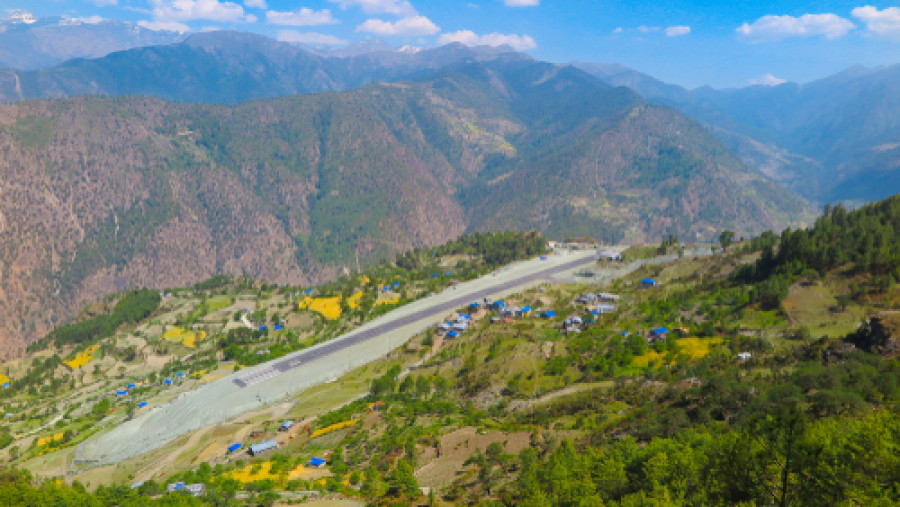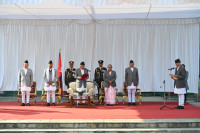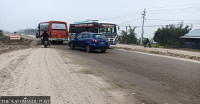National
Buddha Air plans to fly to remote areas could be a game changer in domestic aviation, experts say
Despite the high risks, short take-off and landing flights to mountain airfields are an untapped market with incomes rising.
Sangam Prasain
There are 49 airports in Nepal and six more are being built. Of the existing airports, 20 are not even in operation, not because of the poor condition of the airports but largely because the nine domestic airlines do not want to fly there.
They have their reasons.
“Due to risk factors and high operating costs, private airlines cut down flights to the remote sector and the air connectivity with remote mountain regions started to get cut off [from the country’s air network],” said DR Niraula, a retired captain who flew to the remote airfields of Nepal for more than 12 years with Nepal Airlines.
But now with Buddha Air, which has 60 percent of the domestic market, deciding to add short take off and landing, or STOL, aircraft to its fleet with a view to flying to the remote airfields, the scenario may change and there may be more airlines flying there.
“We have already started the process to select the appropriate aircraft for our STOL operation,” Birendra Bahadur Basnet, managing director of Buddha Air, told the Post.
The company plans to start operations with these aircraft in September next year.
Observers say this could be a game changer.
“The remote or mountain airfields are an unexplored market,” said Tri Ratna Manandhar, former director general of the Civil Aviation Authority of Nepal. “People’s incomes have grown significantly in the mountain regions and as a result demand for air transport has also grown.”
At present only four domestic airlines serve the remote airfields, excluding Lukla, the gateway to Everest, in the mountains of Nepal. These include Nepal Airlines, Tara Air, a subsidiary of Yeti Airlines, Summit Air and Sita Air.
Industry insiders said that Buddha Air’s entry into the STOL operation would revitalise the aviation service, giving a much-needed boost to the connectivity in the mountain and remote sector.
“It’s difficult to expand the wings in the remote sector. But given the brand value of Buddha Air, its investment in safety and its management efficiency, it can become successful in the remote sector as well,” said Niraula.
Buddha Air has been aspiring to fly in the remote sector for a long time. According to Manandhar, nearly one and a half decades ago, it had applied for the operation of the single-engine aircraft but the plan fell apart as the government’s policy was against operating the single-engine planes.
During its heydays, Nepal Airlines, or Royal Nepal Airlines as it was called before the political changes of 2006, used to fly a dozen of de Havilland Canada DHC-6 Twin Otter, a 19-passenger STOL aircraft, covering almost all remote and mountain airfields. But the entry of the private sector in the aviation industry with the economic liberalisation in the early 1990s started to erode the market of Nepal Airlines.
Nepal Airlines had first acquired a Twin Otter in 1971.
Of the 12 Twin Otters it once owned, only three are airworthy today and one of them has been leased to Yeti Airlines.
The value of STOL aircraft in a mountainous country like Nepal is tremendous for connectivity as they can land on airfields that are just over 300 metres long, in contrast to at least 1,200 metres long in the plains, and flights from the larger airfields to them are less than 30 minutes long.
However, the high cost of operation and flying in the harsh geographical terrain where weather frequently and suddenly changes making visibility poor have made the mountain airfields a least attractive sector for private operators even though the competition is fierce in other routes.
According to the civil aviation regulator’s recent aviation safety report, during the last ten years (2009-2019), aircraft operating in the STOL sector have suffered comparatively more accidents than aircraft operating in the trunk sector, which has flights of more than 30 minutes and are in high demand.
Out of 20 accidents that occurred during the period, 17 occurred in the STOL sector.
“It’s understandable how much risk is involved in STOL operation. A crash may damage reputation and ruin the company financially. So success is not easy in remote sectors,” said Niraula.
While aircraft can land in the plains even during heavy rains, poor visibility during even light rain in the mountains often forces aircraft carrying passengers to turn back incurring losses for the airlines companies.
“Obviously, there are some risk factors but there are opportunities equally as well,” said Manandhar. “The commercial flights on the mountain airfields will also increase the tourism prospects.”
For example, the Karnali region has vast potential for adventure and religious tourism but travelling there is very expensive.
Another case in point for the importance of STOL airfields is the Manthali airport in Ramechhap, a five-hour drive from Kathmandu, which served as the departure point for Lukla flights last year when the Tribhuvan International Airport was partially closed for renovation.
The government now plans to expand the 530-metre-long runway of Manthali airport to 900 metres and work on it has already begun.
Once upgradation is completed, civil aviation authorities plan to make Manthali airport base for the flights to Lukla.
Niraula, the retired captain, said it’s the right time to begin STOL operation when the airlines are competing in the trunk route sector.
“All operators are focusing on the trunk routes and there is cut-throat competition in the sector,” he said. “Nonetheless, most of the airlines are planning to buy bigger aircraft like ATR and hence competition will be even fiercer. But no one has a plan to tap the remote market.”
According to Manandhar, investment-wise also, it’s the right time to begin operation as the market price of planes has also come down markedly and pilots and engineers are easily available.
Buddha Air has planned to invest over Rs500 million in the initial phase, excluding the Rs250 million paid-up capital required to establish a new company, which will be a full subsidiary of Buddha.
According to Basnet, they have been studying the viability of three different aircraft—the de Havilland Canada DHC-6 Twin Otter, currently marketed as the Viking Air DHC-6 Twin Otter; Let-410 aircraft, a twin-engine 19-seat aircraft produced by a Czech company, and the Cessna 408 SkyCourier, an American twin-turboprop under development by Textron Aviation.
“The aircraft will be finalised within the next three months,” he said.
According to an official at the Civil Aviation Authority of Nepal, Buddha has been inquiring about the Chinese aircraft Nepal Airlines wants to get rid of as well, asking whether it was a management failure to fly them or they really are not suitable to serve the mountain airfields.
Initially, Buddha Air will begin operation with three aircraft and in the first phase, it will begin operation to the eastern region through Manthali airport base and western region through Pokhara base.
STOL aircraft can fly to mountain airfields of Tumlingtar, Bhojpur, Ilam and Taplejung, among others, from Manthali and Jomson and Manang from Pokhara.
Air connectivity to the remote regions has been a priority of the Nepali state.
The National Human Rights Commission and parliamentary committees have, on different occasions, directed the government to provide easy and affordable flight services to people in remote areas to fulfil its social obligation.
The upcoming new tourism policy has also envisaged an ambitious regional air connectivity scheme that aims to connect unserved and under-served routes of all seven provinces with their respective capitals.
“The civil aviation body is working on a new modality under which the respective provincial governments would subsidise at least 40 percent of airlines seats, which is the break-even load factor of any domestic aircraft to encourage airlines to fly to remote areas,” said Rajan Pokhrel, director general of the Civil Aviation Authority of Nepal.
The civil aviation body currently charges Rs200 per passenger as airport service fee in the domestic sector, except in remote airports. The authority has recommended raising it to Rs300.
According to Pokhrel, around Rs300 million can be raised annually by levying extra fee and it’s sufficient to subsidise domestic airlines to encourage them to fly to remote destinations and offset the high cost of operating such services.
The subsidy would mean an airline gets financial compensation for 40 percent of their seats even if they flew empty.
This, however, is not the first time that the government has attempted to have private airlines fly to remote airfields.
In 2002, the government had set up the Remote Area Air Service Fund in a bid to encourage domestic airlines to fly to remote destinations by giving them subsidies to offset the high cost of operating such services.
The service fund was used to subsidise operations in remote areas as most carriers were reluctant to fly to out-of-the-way places as it is not profitable.
As per government policy, private airlines were required to schedule at least 40 percent of their services to the rural sector. If they did not fly to remote destinations, they had to contribute to the service fund to compensate other airlines. However, these measures were not effective and were cancelled after only six months. Tourism Ministry officials said that more than Rs4 million had been collected in the fund.
Airlines had to contribute at least $4 per passenger in mountain flights and at least $2 per foreign passenger in other sectors to the fund. Charter airlines and helicopter services had to deposit 2 percent of the fare in the fund.
But Manandhar is optimistic that it will make economic sense for the private airlines to serve the country’s remote areas by air as there is a demand given rising incomes and with it people seeking comfort.
“Almost all locations where airports are built have motorable roads but it takes 6 to 7 hours to get there,” said Manandhar. “Flights can cut that time to 30 minutes.”




 10.12°C Kathmandu
10.12°C Kathmandu















